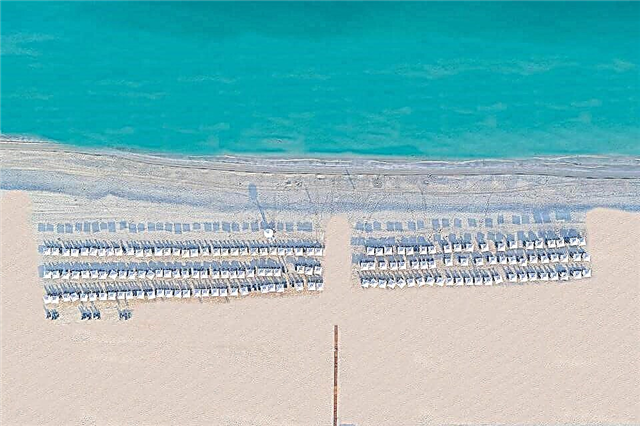Walking along the streets of the ancient city, admiring its hills, palaces, ancient ruins, it is as if you are reliving the history of mankind again and again, frozen in the eternal sights of Rome. The glitter of the lights of advertising signs, new architectural structures, and traffic flows does not interfere with plunging into the atmosphere of bygone times. The main thing is to think carefully about what to see in Rome in 2 days on your own and organize a tireless walking tour. An approximate trekking plan may include a visit to the central part of the city.
How to get from the airport to the center

Suppose that the acquaintance with the country begins with an international airport (for example, the largest in Fiumicino). There are a number of taxis parked next to it. For a high fee, you can quickly travel to any area of Rome. A more economical way is to travel by rail with the economical Leonardo Express train. The train station is at the airport and trains leave every half hour. The journey takes 40 minutes. the ticket price is about 15 €. A popular way to get to Rome city center is to book a car with a driver.
First day

The city does not have a central square surrounded by ancient churches and palaces. Ancient Rome was all the center, and all roads led to the famous imperial forums. On them life flowed with its sorrows, joys. Now the historical center of Rome is called the area between the river and the seven hills. Here the settlement created by Romulus was born, Caesar reigned, Michelangelo and Cellini created their eternal masterpieces.
Villa Borghese

The ancient park on the slopes of Pincho Hill cannot be explored in detail quickly, in one walk. You can only relax a little in the green heart of Rome and see the ancient masterpieces created by the hands of famous masters. Villa Borghese appeared here around 1610. The lands of the central part of the city were transferred to the possession of the famous family in the middle of the century. Famous sculptors and architects were involved in the construction of the villa for Cardinal Shipione Borghese. At the same time, a "pleasure park" was born.
The cardinal was considered a fan of art and sculptures. He was able to organize a famous gallery of works of art created in antiquity. Now there are about 600 paintings, hundreds of sculptures from different times, fresco panels, painted ceilings, floors of rare marble. The walls of the villa are decorated with paintings by Caravaggio, Raphael, Titian, Rubens, Veronese. Steps of the famous Spanish Steps lead to the villa. It has long become not just a beautiful building in the park, but an important National Museum with a huge number of art objects.
Viewpoint on Pincho Hill

The beginning of the two-day hike in Rome from Villa Borghese was not chosen by chance. At the top of the most famous hill, you can breathlessly see the entire center of the ancient city at once. Consider its majestic buildings, streets hidden between buildings, a beautiful park. Unique water clock, standing in a small tower in the middle of a pond next to the observation deck, and think about the further route.
Roads are laid along the slope of the hill, forming tiers at different heights. From anywhere you can admire the surroundings. Endless roofs made of bright tiles, narrow streets, domes, spiers of churches, the contours of architectural structures from different eras amaze with harmony and grandeur. The panoramic view is complemented by the beautiful greenery of the park, which lives on a hill.
Piazza del Popolo

The gardens of the Pincio hill make Piazza del Popolo even more beautiful, hanging over it with a green tent, guarding its ancient history. In the most famous square, residents of the city gathered for trade, making important decisions. Here terrible executions took place, the main roads of Rome began. The sounds of water in the old aqueduct, the sound of footsteps on the preserved pavements remind of the times when fearless warriors walked along the Flaminia road. The name of the square is determined by the meaning "people".
The formation of the square began in the 16th century. Its modern appearance appeared in the IXX century. Ancient architectural elements have been preserved (the Church of Santa Maria, twin churches, fountains, an obelisk, statues, a fortress wall of 273). The old rectangular square has turned into an ellipse bounded by a beautiful balustrade. It is decorated with an interesting sculptural group "Seasons".
In the center of the square stands a unique Egyptian obelisk, which used to stand next to the temple to the god Ra in Egypt. The three-level square has become a favorite hiking spot. During its design, it was possible to implement a single ensemble of the city using ancient buildings. On their first floors, there are numerous shops, cafes, boutiques that are interesting for tourists.
Spain square

The name of the square is associated with the appearance of the Polish embassy. By the arrival of the first Spaniards in the 17th century, there were many hotels for foreigners, beautiful buildings. The embassy is located in the luxurious palace of Monaldeschi. In its northern part, the Church of Trenita dei Monti, built in the 16th century by order of Louis XII, has been preserved. Divine services in French are still heard under its vaults. There is a legend that at night the ghost of Cagliostro's beloved Lorenza Felicini walks on the square.
An important attraction of the square is the famous Barcaccia fountain. An ancient engineering structure that made it possible to solve technical problems of water delivery from the Aqua Virgo aqueduct. It is made of snow-white marble in the shape of a flooded boat, from which water flows. It shows the heraldic symbols of the sun and bees belonging to the Barberini dynasty. The monument reminds the residents of the city of the flood of 1598. Nearby is another unique place of the Spanish Steps.
Spanish Steps

Plaza de España begins at the foot of the stairs leading to the Trinita dei Monti church. It was built in 1726 by the architects Specchi, de Sanctis. 138 steps made of travertine have an original concave shape, different sizes, and span widths. At any time of the year, a festive atmosphere reigns on the steps. Walkers gather here, celebrations take place. In the spring, the staircase is decorated with blooming azaleas; on Christmas, performances take place here.
Famous couturiers present new collections here. Since the development of cinematography, the staircase has often been used as a necessary set. The film "Roman Holiday" was filmed there. The steps of the stairs serve as an excellent viewing platform. They offer views of the beautiful surroundings. The architectural landmark of the Baroque style has become a favorite place for young people.
Trevi Fountain

Not far from the Spanish Steps is a small square called Piazzadi Trevi. In its center stands the world famous Trevi Fountain. Seahorses, newts pull the sea shell, in which sits the king of the seas, oceans formidable Neptune. He is accompanied by numerous allegorical figures. He leaves the niche of the Palazzo Poli. Together with the facade of the palace, the sculptural forms look harmonious and impressive. The fountain is 26 m high and 22 m wide.
The landmark was created around 1762 by the architect Salvi. Around the fountain there are steps in the shape of an antique amphitheater. They are always busy with a romantic-minded audience. The film "LaDolceVita" was filmed against the background of the silver streams of the fountain. The famous model Claudia Schiefer bathed in them. The composition is equipped with original lighting at night. To see her again, you need to throw a coin into the fountain and make a wish.
Pantheon

The temple dedicated to all gods appeared in 27 BC.It was originally pagan and much later converted to Christianity. Since 609, it has become the Church of St. Mary and the Martyrs. On major holidays, services are still held in it. The majestic structure, erected in the form of a rotunda, with columns, a dome is well preserved. It has become a model of excellence on earth. The pantheon contains tombs of famous names from the ancient world.
Among them are the burials of Raphael Santi, Victor Emmanuel II, and other kings of the country. In the center of the dome there is a small "Pantheon's eye" or "ocupus" window. Light passes through it, and during the prayer service, rose petals are thrown from here, symbolizing the descent of the Holy Spirit. There is a legend that the hole was made by evil spirits fleeing from the temple at the sound of the first mass. The inner walls of the Pantheon are lined with marble; porphyry slabs have been preserved on the floor.
Ancient frescoes, statues of Agrippa, Hadrian at the entrance, a massive bronze door, powerful walls (their thickness is 6 m), covered with scars of centuries and going deep underground, create a feeling of two thousand years of antiquity. On the neat facade with columns and a huge dome, one can see the inscription “M. AGRIPPA L F COS TERTIUM FECIT ".
Castel Sant'Angelo
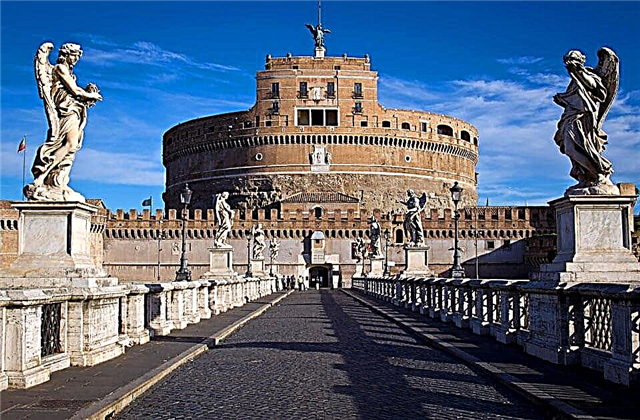
The architectural ensemble was formed during the reign of Emperor Hadrian. A huge building in the shape of a cube, faced with marble, travertine, decorated with a mausoleum made of volcanic stone, served as a burial vault for members of the imperial family, Anthony Piya, Mark Anthony and many confidants (urns with ashes are lost). The tomb got its name (as follows from the existing legend) in honor of the Archangel Michael on the occasion of the end of the plague epidemic in 590. A statue created by Montelupo appeared on the territory of the castle (courtyard of the Angel).
Visitors to the Castel Sant'Angelo are invited to explore the following attractions:
- Savior's courtyard. The execution of the convicts took place at this place. In the chapel of the Holy Crucifixion, they prayed for the last time. Through the Roman atrium it was possible to go to the tomb of Hadrian.
- Courtyard of the Angel with the Clement III room, a beautiful bathhouse designed by Giovanni da Udine.
- Treasury. The wealth of the pontiffs was kept in it, there was a library, apartments of Count Cagliostro.
- Angel's Terrace. It offers a panoramic view of the city.
- Covered gallery with the rooms of Perseus, Via Paolina, arsenal.
- Corridor, hall. Here was the remains of the emperor. The banners of the Italian infantry are now kept.
Umberto Bridge I

A three-arch bridge was built across the Tiber River by the project of the architect Angelo Vescovali around 1895 (the bridge was erected within 10 years). He connected the city center with the surrounding area. The length of the ancient structure reaches 105 m, width 20 m. King Umberto I and his wife Margaret of Savoy were present at the opening of the bridge. Driving over the bridge allowed you to quickly find yourself next to the Constitutional Court in the Palace of Justice.
For tourists, the building serves as an excellent viewing platform, overlooking the St. Peter's Cathedral, built in the 16th century, the ancient pedestrian bridge of St. Angel. This is one of the opportunities for a short trip to Rome to see the statues created by the famous Bernini in the Baroque style (out of 10 statues, two were made by the master himself, the rest by his students). In the hands of every angel are the instruments that caused the suffering of Christ. Each statue has lines from the scriptures written on it.
Second day

In the early morning of the second day of your trip to Rome, it is useful to have a cup of coffee in one of the Piazza Navona cafes, to taste the famous Tartufo ice cream, invented here. At the same time, do not forget to visit the famous “Pope Carlo” shop, take a photo next to Pinocchio, ride with the children around the ancient city in the Time Elevator time machine and think over a plan for a difficult hiking trip to the sights of Rome.
Coliseum
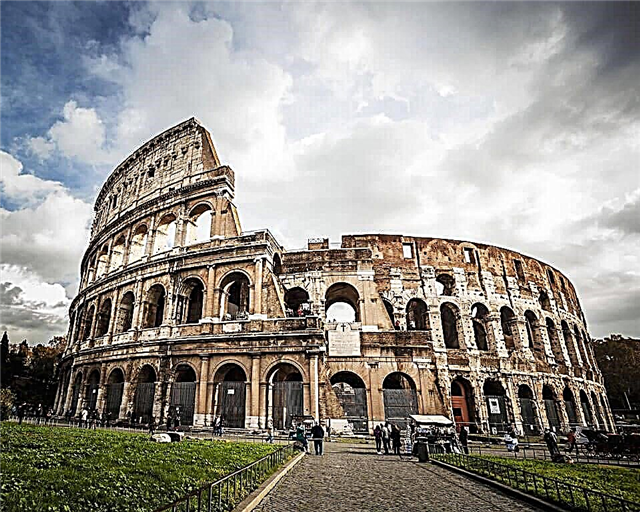
The visiting card of Rome now does not serve as a venue for the famous gladiatorial battles. The sad monument of ancient Rome served as a theater "giving bread and circuses" to the rulers of the country, confirming the power of their power. Events that took place on the site of the greatest architectural creation distracted residents from the outrage over the current policy. The Colosseum was built on the lands of the hated Nero.
Previously, there was a tall statue of Nero, made of bronze, covered with gold. The celebration in honor of the opening of the Colosseum lasted for almost 100 days. During its holding, almost 2 thousand brave gladiators and 3 thousand animals, kept in the undergrounds of the Colosseum, were killed. The bodies of the dead were dumped into a deep well specially built on the territory. Initially, the Colosseum (colossal) was called the "Flavian Amphitheater", "Caesar's Amphitheater", "Arena".
Architecturally, the Colosseum did not look like classical temples with columns and beautiful pediments. The many arches of the Colosseum are honeycomb-like, connected in an elliptical shape. Now the fragments of the building have been preserved for tourists, the dungeons have been excavated, and the third tier, a wooden path in the auditorium, has been restored. Sometimes near the ancient walls there are concerts, services of the Pope. In 2007, the remaining ruins were included in the UNESCO World Heritage List.
Arch of Constantine

Coming out of the territory of the Colosseum, one cannot fail to notice the ancient Arch of Constantine. The first mention of the sights dates back to 315. This is one of the oldest monuments of the past. The arch is 21 meters high. It is decorated with statues, bas-reliefs brought from different historical areas of Rome. The arch is considered a symbol of the transfer of power to the Catholic Church from the emperors.
There is a legend according to which the emperor Constantine (who visited Rome only twice), during the battle at the Malvian bridge, noticed a cross in the sky and heard the words "Conquer by this". He accepted the cross and defeated the emperor Maxentius. In honor of this victory, the Arch of Constantine was built. At the same time, the emperor's architects used decorations of other structures, replacing the faces of the previous rulers of Rome with the image of Constantine. At this time, the emperor, who was a pagan, converted to Christianity.
Arch of Titus

According to the ancient traditions of Rome, any victory was accompanied by a solemn entry into the city center with trophies captured through special arches. The main life took place in the Roman Forum, surrounded by magnificent buildings. One of them was a beautiful arch built to commemorate the victory of Emperor Titus after the capture of Jerusalem. It was erected in 81 during the reign of the son of Titus on the Sacred Road connecting the Capitol and Palantin hills. On one side of the arch you can see the Colosseum, on the other, the Roman Forum. The height of a single-span arch reaches 15.4 m, width 13.5 m, depth 4.75 m.
It is decorated with semi-columns made of Pentel marble. In the corners are carved figures of the winged Victoria. The inner walls of the arch are decorated with interesting bas-reliefs depicting a trophy procession after the war. An inscription with information about the war has been preserved above the flight. Previously, the arch was decorated with a statue of Titus on a Roman chariot with four horses. The arch is one of the finest examples of ancient architecture in Rome.
Roman forum
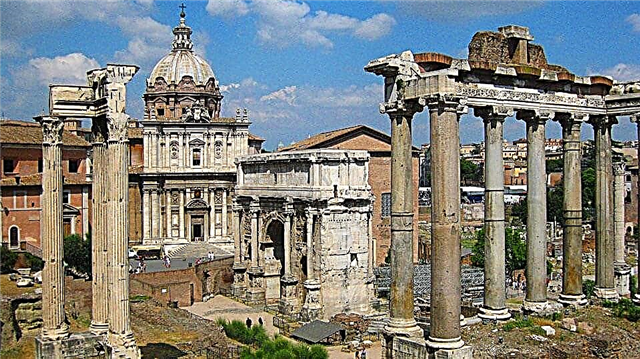
In the ancient empire, the political and religious center of Rome was located here. "The path of sorrow and joy" was this road. It sounded the victorious sounds of the commanders who returned from successful battles, the soldiers marched, the sad melodies of the chains on the legs of the prisoners were heard. A road was created on the territory of impassable swamps between three hills. In the VIII century BC. NS. burials were carried out here. Tarquinius Priscus ordered to drain the valley, make a sewer, tamp the road.
Buildings gradually grew on the site, the central square of the city, called the Roman Forum, was formed. In the bustling city center, trade and court cases took place. After the fall of the Roman Empire, the forum fell into decay. Archaeological excavations took place in the 19th century.Now it is considered an iconic place of the city and is located 10 meters below ViadeiForiImperiali. The ruins of the Roman Empire are still hidden under the busy modern highway.
Nerva Forum

Among the imperial roads of Rome, the forum was the smallest. The forum was called Transitorium (meaning passage or passage). The completion of its construction took place during the reign of Domitian in 97. A long section (measuring 120 x 45 m) was located between the Veslasian and August forums. It connected the Roman Forum with the Argilet area. This path in ancient times was called the "Forum of Pallas". It was decorated with the temple of the goddess Minerva, standing not far from the building in honor of Mars the Avenger. In 1606, the sanctuary was destroyed by order of Pope Paul V.
The building materials of the temple were used to build the Aqua Paola fountain, the Borja chapel in the Santa Maria Maggiore church, and the pillar hall. In the XX century, the building was destroyed. The building material was again used for other structures. Later, Mussolini ordered the construction of Via dei Fori Imperiali here. Two columns of white marble have survived from the ancient structure, a part of the facade with the image of Minevra, a frieze with beautiful decor of sculptures. The rest of the forum is under the avenue.
August Forum
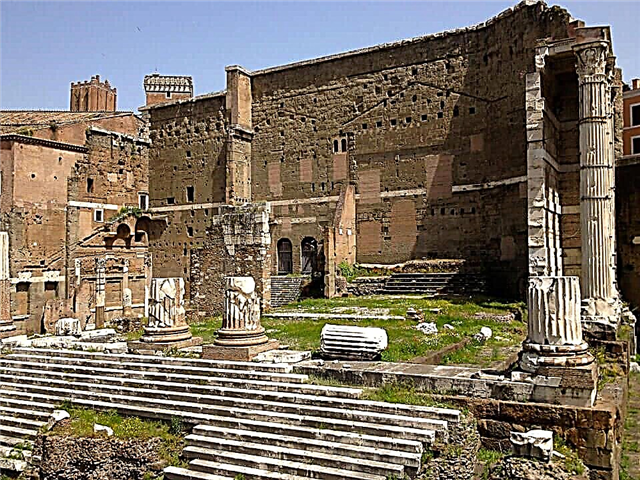
During the reign of Emperor Augustus, the economic center of Rome was formed between hills on the site of small rivers and marshes. Initially, the new "outlet" was located outside the city. The place was quickly ennobled and, together with the growth of Rome, began to be called the Forum of Augustus, which became an active public zone. The main building of the forum was the Temple of Mars the Avenger. Parts of the building have survived: three columns, part of a wall, a staircase leading to the altar, fountains, niches. They talk about its large initial size.
The outer facades of the temple were decorated with statues of gods made by famous ancient masters. In the center was a statue of the god Mars, surrounded by sculptural creations from the figures of Venus, Caesar. After the adoption of Christianity, the economic center, and with it the forum, fell into desolation. The grandiose buildings that surrounded the road were dismantled for the needs of the construction of Christian churches. For a long time the place was called "cow field". Lonely pieces of columns, ruins of buildings, spoke of the former greatness of the forum. An interesting collection of found artifacts is organized on the forum in the open air.
Trajan's Forum

In 106, 113 AD, the architect Apollodorus of Damascus, at the request of Emperor Troyan, created a path 300 m long and 165 m wide.It was located opposite the Roman Forum on the cut Quirinal hill and consisted of a large number of covered colonnades. Among them stands the 40-meter column of Trajan or the dominant of the forum. It was erected from 20 pieces of the purest Carrara marble as a sign of the victory of the Romans over the troops of the Thracian tribes.
Trajan's triumph is depicted across the entire surface of the column in the form of intricate sculptural bas-reliefs. The height of the landmark is 38 m. The column is hollow inside and a spiral staircase runs along it, allowing you to climb to the top. The column still serves as a kind of Trajan's tombstone. At the base of the column there is a door leading to the interior of the column. The urns with the ashes of Trajan and his wife Pompeii Plotina are kept here. While exploring the Forum, the convoy can be seen in the distance for security reasons.
Capitoline Museums

On the Capitoline Hill of Rome, next to the Roman Forum is the most visited complex of attractions in Rome. A ticket to visit the Capitoline Museums must be purchased in advance. For a short stay in the city, it is recommended to visit the three main palaces of the museum ensemble. The primary buildings were destroyed and looted. The revival of the Capitol palaces began at the behest of King Charles V in 1536. The work was supervised by the famous Michelangelo Buanarotti. He was commissioned to create palaces to house the collection donated by Sixtus IV.
It consisted of works of art, coins from different centuries, jewelry, ancient bronze statues. Rare ancient artifacts are still kept in the collections of the palaces. The basis of the complex was: two palaces of the Palazzo Conservatory, Nuovo, Kapitaliyskaya square, the Palace of the Senators. The palaces are connected by underground tunnels passing under the square. Along them, a passage is opened to the Lapidarium gallery with the ruins of ancient dwellings, collections of ancient inscriptions on stones. The entrance to the tunnels is located next to the Roman Forum.
Four expositions can be seen on the square:
- coin museum
- hall of frescoes
- hall pediment with preserved elements of decoration of the Temple of Jupiter
- collection of Santarelli gemstones
The central part of the square with the Capitoline Museums is occupied by a statue of the emperor Marcus Aurelius. This is a rare treasure of antiquity that belongs to museums. The Capitoline Museum houses the world's sculptural masterpieces: the Capitoline she-wolf, the Dying Gaul, the Capitoline Brutus. The boy pulling the splinter Colossus of Constantine.
Monument to Victor Emmanuel II

The representative of the Savoy dynasty Victor Emmanuel II managed to return its lands to the country, to create a single state. He accepted the title of king by the results of the vote of the people of the country in 1861. And he became the first king of the united kingdom. After his measure in 1878, it was decided to create a monument glorifying the king and the entire historical period, called the Risorgimento. It ran from 1815 to 1861 and was associated with the struggle against foreign domination.
For almost 30 years, a grandiose structure has been erected on the slopes of Capitol Hill. Many ancient buildings of this place have been demolished. Among them were the Arch of San Marco, which connected the Palace of Venice with the Capitol, the buildings of the Arcelli monastery, the tower of Paul III. Some of the ancient Roman buildings have survived and are located on the right side of the square. The Monument to the King (Vittoriano) is created in the form of a snow-white monument at the foot of the hill.
He is at the same time simple, graceful, majestic and solemn. The king rides on the high pedestal of Vittoriano. The Altar of the Fatherland is located in the central part of the monument. Interesting bas-reliefs surround it on all sides. The portico of the monument is decorated with statues representing the unity of the 16 regions of Italy. An eternal flame burns at the monument. A guard of honor guards the mogul of the unknown soldier.
Venice square

The construction of the residence of Cardinal Paul II in the middle of the 15th century is considered the beginning of the formation of the largest square in the city. The Palace of Venice was built from the nearest quarries, including the Colosseum. In those days, ancient monuments were not very much appreciated. The holiday lover Paul II moved the festivities to the new square and via del Corso. There was plenty of room for wild horses to race. King Victor Emmanuel banned them after the death of a teenager in 1874.
Roads leading to different parts of the city began from a huge square. The famous street of the Imperial Forums, leading to the Colosseum, begins from it. The square is sometimes referred to as the geometric center of Rome. The central building of the square, the Palace of Venice, was the property of Austria, the embassy of the Republic of Venice, the home of Mussolini's fascist party. His office with a balcony is now adorned with the flag of Italy. Inside the palace is the Museum of the region of the country.
In it you can see paintings dedicated to the historical events of Italy, starting from the Middle Ages. On the square, there is the Shishka fountain, found during archaeological excavations. In the corner of the square, not far from the Church of San Marco, stands the famous "speaking" statue of Madame Lucrezia. According to the traditions of Rome, notes criticizing the authorities, satirical works on political topics were attached to it. These actions are now prohibited.
Travel Tips

Useful tips for tourists making an independent trip around the city:
- For accommodation it is better to choose a hotel room. If you're lucky, you can take part in effective discounts.Cheaper hostel options are offered near a busy train station.
- At McDonald's you can expect a potato, a burger for a very long time. Many convenient pizzerias, cafes for a quick bite next to the Campo dei Fiori morning market.
- Shopping is easy in the large market of Porta Portese. Everything is here. Do not forget about the issue of discounts for any product.
- It is better to buy groceries in shops on Via Cola di Rienzo. It passes next to the Vatican.
- In Rome, the surrounding area, there are two tariffs used to pay for a taxi: the first for the zone within the ring road, the second outside. They differ. It is better to ask about the route of travel before starting the trip.
- 6.For city guests, there are cards that work as travel tickets and allow you to visit at least three museums, archaeological excavations, travel by public transport all day.




